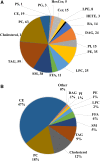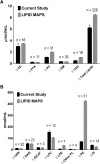Harmonizing lipidomics: NIST interlaboratory comparison exercise for lipidomics using SRM 1950-Metabolites in Frozen Human Plasma
- PMID: 28986437
- PMCID: PMC5711491
- DOI: 10.1194/jlr.M079012
Harmonizing lipidomics: NIST interlaboratory comparison exercise for lipidomics using SRM 1950-Metabolites in Frozen Human Plasma
Abstract
As the lipidomics field continues to advance, self-evaluation within the community is critical. Here, we performed an interlaboratory comparison exercise for lipidomics using Standard Reference Material (SRM) 1950-Metabolites in Frozen Human Plasma, a commercially available reference material. The interlaboratory study comprised 31 diverse laboratories, with each laboratory using a different lipidomics workflow. A total of 1,527 unique lipids were measured across all laboratories and consensus location estimates and associated uncertainties were determined for 339 of these lipids measured at the sum composition level by five or more participating laboratories. These evaluated lipids detected in SRM 1950 serve as community-wide benchmarks for intra- and interlaboratory quality control and method validation. These analyses were performed using nonstandardized laboratory-independent workflows. The consensus locations were also compared with a previous examination of SRM 1950 by the LIPID MAPS consortium. While the central theme of the interlaboratory study was to provide values to help harmonize lipids, lipid mediators, and precursor measurements across the community, it was also initiated to stimulate a discussion regarding areas in need of improvement.
Keywords: National Institute of Standards and Technology; Standard Reference Material 1950; fatty acyls; glycerolipids; lipids; phospholipids; quality control; quantitation; sphingolipids; sterols.
Copyright © 2017 by the American Society for Biochemistry and Molecular Biology, Inc.
Figures



References
-
- Burr G. O., and Burr M. M.. 1929. A new deficiency disease produced by the rigid exclusion of fat from the diet. J. Biol. Chem. 82: 345–367. - PubMed
-
- Burr G. O., and Burr M. M.. 1930. On the nature and role of the fatty acids essential in nutrition. J. Biol. Chem. 86: 587–621.
-
- Steinberg D. 2004. An interpretive history of the cholesterol controversy: part I. J. Lipid Res. 45: 1583–1593. - PubMed
-
- Steinberg D. 2005. An interpretive history of the cholesterol controversy: part II: the early evidence linking hypercholesterolemia to coronary disease in humans. J. Lipid Res. 46: 179–190. - PubMed
-
- Wilson P. W. 2013. Lipids and vascular disease: a Framingham perspective. Glob. Heart. 8: 25–33. - PubMed
Publication types
MeSH terms
Substances
Grants and funding
- P20 RR016475/RR/NCRR NIH HHS/United States
- P01 HL034300/HL/NHLBI NIH HHS/United States
- P01 GM095467/GM/NIGMS NIH HHS/United States
- P01 CA120964/CA/NCI NIH HHS/United States
- P20 HL113452/HL/NHLBI NIH HHS/United States
- U24 DK097209/DK/NIDDK NIH HHS/United States
- U24 DK097154/DK/NIDDK NIH HHS/United States
- R01 DK064391/DK/NIDDK NIH HHS/United States
- P30 DK020541/DK/NIDDK NIH HHS/United States
- UL1 TR001873/TR/NCATS NIH HHS/United States
- P30 CA006516/CA/NCI NIH HHS/United States
- S10 RR027926/RR/NCRR NIH HHS/United States
- U54 GM069338/GM/NIGMS NIH HHS/United States
- R01 GM020501/GM/NIGMS NIH HHS/United States
- UL1 TR000040/TR/NCATS NIH HHS/United States
- P60 DK020541/DK/NIDDK NIH HHS/United States
LinkOut - more resources
Full Text Sources
Other Literature Sources
Research Materials

